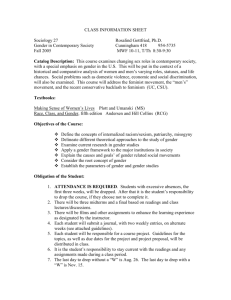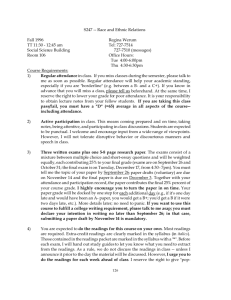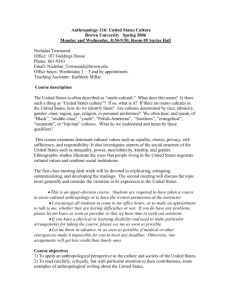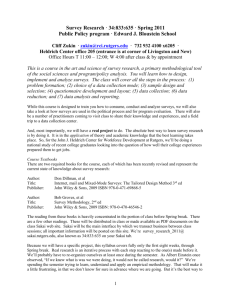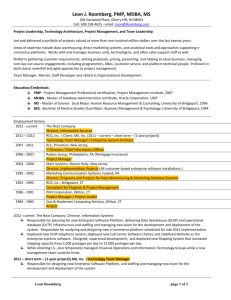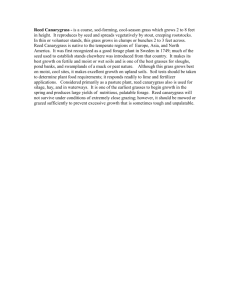Treatment Effect Should use Could use Should not use
advertisement
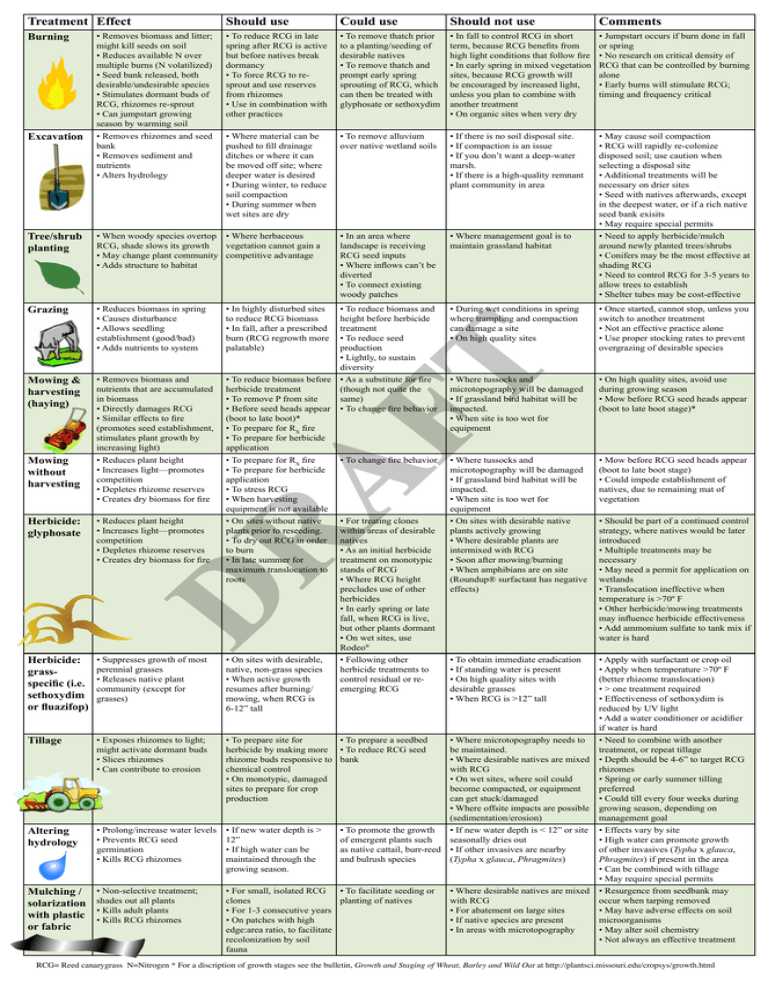
Treatment Effect Should use Could use Should not use Comments Burning • To reduce RCG in late spring after RCG is active but before natives break dormancy • To force RCG to resprout and use reserves from rhizomes • Use in combination with other practices • To remove thatch prior to a planting/seeding of desirable natives • To remove thatch and prompt early spring sprouting of RCG, which can then be treated with glyphosate or sethoxydim • In fall to control RCG in short term, because RCG benefits from high light conditions that follow fire • In early spring in mixed vegetation sites, because RCG growth will be encouraged by increased light, unless you plan to combine with another treatment • On organic sites when very dry • Jumpstart occurs if burn done in fall or spring • No research on critical density of RCG that can be controlled by burning alone • Early burns will stimulate RCG; timing and frequency critical • Where material can be pushed to fill drainage ditches or where it can be moved off site; where deeper water is desired • During winter, to reduce soil compaction • During summer when wet sites are dry • To remove alluvium over native wetland soils • If there is no soil disposal site. • If compaction is an issue • If you don’t want a deep-water marsh. • If there is a high-quality remnant plant community in area • In an area where landscape is receiving RCG seed inputs • Where inflows can’t be diverted • To connect existing woody patches • Where management goal is to maintain grassland habitat • May cause soil compaction • RCG will rapidly re-colonize disposed soil; use caution when selecting a disposal site • Additional treatments will be necessary on drier sites • Seed with natives afterwards, except in the deepest water, or if a rich native seed bank exisits • May require special permits • Need to apply herbicide/mulch around newly planted trees/shrubs • Conifers may be the most effective at shading RCG • Need to control RCG for 3-5 years to allow trees to establish • Shelter tubes may be cost-effective Excavation • Removes biomass and litter; might kill seeds on soil • Reduces available N over multiple burns (N volatilized) • Seed bank released, both desirable/undesirable species • Stimulates dormant buds of RCG, rhizomes re-sprout • Can jumpstart growing season by warming soil • Removes rhizomes and seed bank • Removes sediment and nutrients • Alters hydrology Tree/shrub planting • When woody species overtop • Where herbaceous RCG, shade slows its growth vegetation cannot gain a • May change plant community competitive advantage • Adds structure to habitat Grazing • Reduces biomass in spring • Causes disturbance • Allows seedling establishment (good/bad) • Adds nutrients to system Mowing & harvesting (haying) • Removes biomass and nutrients that are accumulated in biomass • Directly damages RCG • Similar effects to fire (promotes seed establishment, stimulates plant growth by increasing light) • Reduces plant height • Increases light—promotes competition • Depletes rhizome reserves • Creates dry biomass for fire • Reduces plant height • Increases light—promotes competition • Depletes rhizome reserves • Creates dry biomass for fire Herbicide: grassspecific (i.e. sethoxydim or fluazifop) • Suppresses growth of most perennial grasses • Releases native plant community (except for grasses) Tillage Altering hydrology Mulching / solarization with plastic or fabric DR Herbicide: glyphosate • To reduce biomass and height before herbicide treatment • To reduce seed production • Lightly, to sustain diversity • To reduce biomass before • As a substitute for fire herbicide treatment (though not quite the • To remove P from site same) • Before seed heads appear • To change fire behavior (boot to late boot)* • To prepare for RX fire • To prepare for herbicide application • To prepare for RX fire • To change fire behavior • To prepare for herbicide application • To stress RCG • When harvesting equipment is not available • On sites without native • For treating clones plants prior to reseeding. within areas of desirable • To dry out RCG in order natives to burn • As an initial herbicide • In late summer for treatment on monotypic maximum translocation to stands of RCG roots • Where RCG height precludes use of other herbicides • In early spring or late fall, when RCG is live, but other plants dormant • On wet sites, use Rodeo® • On sites with desirable, • Following other native, non-grass species herbicide treatments to • When active growth control residual or reresumes after burning/ emerging RCG mowing, when RCG is 6-12” tall • During wet conditions in spring where trampling and compaction can damage a site • On high quality sites AF T Mowing without harvesting • In highly disturbed sites to reduce RCG biomass • In fall, after a prescribed burn (RCG regrowth more palatable) • Once started, cannot stop, unless you switch to another treatment • Not an effective practice alone • Use proper stocking rates to prevent overgrazing of desirable species • Where tussocks and microtopography will be damaged • If grassland bird habitat will be impacted. • When site is too wet for equipment • On high quality sites, avoid use during growing season • Mow before RCG seed heads appear (boot to late boot stage)* • Where tussocks and microtopography will be damaged • If grassland bird habitat will be impacted. • When site is too wet for equipment • On sites with desirable native plants actively growing • Where desirable plants are intermixed with RCG • Soon after mowing/burning • When amphibians are on site (Roundup® surfactant has negative effects) • Mow before RCG seed heads appear (boot to late boot stage) • Could impede establishment of natives, due to remaining mat of vegetation • Should be part of a continued control strategy, where natives would be later introduced • Multiple treatments may be necessary • May need a permit for application on wetlands • Translocation ineffective when temperature is >70º F • Other herbicide/mowing treatments may influence herbicide effectiveness • Add ammonium sulfate to tank mix if water is hard • To obtain immediate eradication • If standing water is present • On high quality sites with desirable grasses • When RCG is >12” tall • Apply with surfactant or crop oil • Apply when temperature >70º F (better rhizome translocation) • > one treatment required • Effectiveness of sethoxydim is reduced by UV light • Add a water conditioner or acidifier if water is hard • Exposes rhizomes to light; • To prepare site for • To prepare a seedbed • Where microtopography needs to • Need to combine with another might activate dormant buds herbicide by making more • To reduce RCG seed be maintained. treatment, or repeat tillage • Slices rhizomes rhizome buds responsive to bank • Where desirable natives are mixed • Depth should be 4-6” to target RCG • Can contribute to erosion chemical control with RCG rhizomes • On monotypic, damaged • On wet sites, where soil could • Spring or early summer tilling sites to prepare for crop become compacted, or equipment preferred production can get stuck/damaged • Could till every four weeks during • Where offsite impacts are possible growing season, depending on (sedimentation/erosion) management goal • Prolong/increase water levels • If new water depth is > • To promote the growth • If new water depth is < 12” or site • Effects vary by site • Prevents RCG seed 12” of emergent plants such seasonally dries out • High water can promote growth germination • If high water can be as native cattail, burr-reed • If other invasives are nearby of other invasives (Typha x glauca, • Kills RCG rhizomes maintained through the and bulrush species (Typha x glauca, Phragmites) Phragmites) if present in the area growing season. • Can be combined with tillage • May require special permits • Non-selective treatment; • For small, isolated RCG • To facilitate seeding or • Where desirable natives are mixed • Resurgence from seedbank may shades out all plants clones planting of natives with RCG occur when tarping removed • Kills adult plants • For 1-3 consecutive years • For abatement on large sites • May have adverse effects on soil • Kills RCG rhizomes • On patches with high • If native species are present microorganisms edge:area ratio, to facilitate • In areas with microtopography • May alter soil chemistry recolonization by soil • Not always an effective treatment fauna RCG= Reed canarygrass N=Nitrogen * For a discription of growth stages see the bulletin, Growth and Staging of Wheat, Barley and Wild Oat at http://plantsci.missouri.edu/cropsys/growth.html Please cite as: Wisconsin Reed Canarygrass Management Working Group. 2006. Reed canarygrass control practices: effects and management recommendations A reference table for landowners and restoration professionals Reed Canarygrass Control Practices: Effects and Management Recommendations A few things to remember... Although the recommended reed canarygrass control practices are based on advice from experienced practitioners and researchers, they have not been fully tested in a field setting. Following recommendations from this table does not guarantee control and/or eradication of reed canarygrass. Site-specific conditions and timing variables are likely to influence results. When applying chemical herbicides, be sure to follow all safety precautions and label recommendations. Over-application or unintended use of pesticides can potentially harm the environment and pose a safety risk to the user. Controlling reed canarygrass may result in other invasive or undesirable species attempting to colonize the site after suppression of the reed canarygrass. Follow-up monitoring or control of other invasives may be needed. When tractors, mowers, or bulldozers are used in reed canarygrass control, be aware of the potential to pass on seeds, rhizomes or other plant parts to new locations unless equipment is cleaned after use. Federal, state and local permits may be required when performing restoration work in wetlands or along waterways. Contact your local DNR office or county zoning administrator before initiating reed canarygrass control work. Contributors: Craig Annen, Tom Bernthal, Thomas Boos, Mike Casler, Judy Derricks, Jerry Doll, Patricia Haack, Mike Healy, Rich Henderson, John Jackson, Kelly Kearns, Greg Kidd, Art Kitchen, Rhonda Krueger, Matt Otto, Pat Trochlell, Robert Weihrouch, Julia Wilcox and Joy Zedler This publication is part of an ongoing effort to sythesize and develop effective means of controling invasive reed canary grass in natural areas. For more information, contact: Art Kitchen Wisconsin Private Lands Office 4511 Helgesen Drive Madison, WI 53718 (608) 221-1206 x 13 (office) e-mail: art_kitchen@fws.gov Design funded by EPA Wetland Protection Grant #: CFDA #66.461 under Wisconsin DNR contract NME00000830 First printing, January 2006
